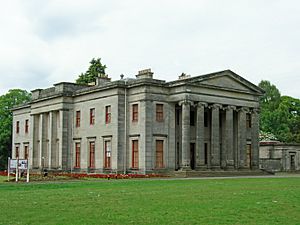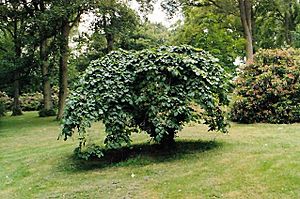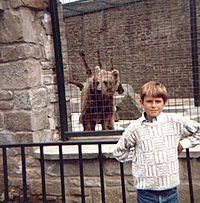Camperdown Country Park facts for kids
Quick facts for kids Camperdown House |
|
|---|---|

Camperdown House, June 2006
|
|
| Area | 400 acres (1.6 km2) |
|
Listed Building – Category A
|
|
| Designated | 12 July 1963 |
| Reference no. | LB25078 |
|
Inventory of Gardens and Designed Landscapes in Scotland
|
|
| Designated | 1 July 1987 |
| Reference no. | GDL00082 |
| Lua error in Module:Location_map at line 420: attempt to index field 'wikibase' (a nil value). | |
Camperdown Country Park, often called Camperdown Park, is a large public park in Dundee, Scotland. It used to be the private land of Camperdown House, a huge mansion built in the 1800s. The city of Dundee bought the park in 1946.
Today, Camperdown Park is a popular place for families and friends. It has a special wildlife centre and lots of fun activities. It's the biggest park in Dundee, covering about 400 acres (1.6 square kilometers). You can find over 190 different types of trees growing here.
Camperdown House is known as the biggest "Greek Revival" style house left in Scotland. This means it was designed to look like ancient Greek temples. Both the house and the park are protected because they are very important historical sites.
Contents
History of Camperdown Park
The land where Camperdown Park now stands was first known as Lundie. A man named Alexander Duncan bought it in 1682. There was already a house on the estate from the 1500s. Several members of the Duncan family became the main leader of Dundee, called the Provost, in the 1700s.
Admiral Adam Duncan's Victory
A famous member of the family was Admiral Adam Duncan. In 1797, during a war with France, he led the British Navy. His fleet won a big battle against the Dutch navy. This battle was called the Battle of Camperdown. Because of his victory, Admiral Duncan was given a special title: Viscount Duncan.
Building Camperdown House
In 1820, Admiral Duncan's son, Robert, decided to build a new house. He hired a famous architect named William Burn. The old house was taken down, and the new Camperdown House was finished in 1828. Lord Duncan renamed the house and its land "Camperdown" to remember his father's great victory. In 1831, he was given an even higher title: Earl of Camperdown.
Lord Camperdown also designed the beautiful parklands around the house. He worked with his forester, David Taylor. Together, they planted most of the park's many trees between 1805 and 1859.
After the 4th Earl of Camperdown passed away in 1933, the family title ended. The house and its contents were sold. In 1946, the city of Dundee bought Camperdown. The park officially opened to everyone in 1949.
The Camperdown Elm Tree
Camperdown Park is famous for a special type of tree called the Camperdown Elm (Ulmus glabra 'Camperdownii'). This tree has a unique, weeping shape. It was discovered around 1835-1840 by David Taylor, the park's head forester. He found a strange branch of a wych elm tree growing along the ground.
The Earl's gardener then took a piece from this unusual branch. He attached it, or "grafted" it, onto the trunk of a normal wych elm tree. This created the very first Camperdown Elm. Today, every Camperdown Elm tree in the world comes from a piece taken from that original tree in Camperdown Park.
What to Do at Camperdown Park
Camperdown Park offers many activities for visitors. It's a great place to spend a day outdoors.
Camperdown Wildlife Centre
The Camperdown Wildlife Centre is home to over 300 animals. These animals belong to about 50 different species. Most of the animals are mammals and birds, but there are also some reptiles. The centre is part of BIAZA, an organization that makes sure zoos take good care of their animals.
The brown bears are some of the most popular animals at the centre. In 2016, one bear named Comet passed away. Another bear, Star, was joined by three younger bears. Star passed away in 2018. You can also see the pine marten, which is one of Britain's rarest mammals. The centre received its official "zoo licence" in 2003.
In 1986, a young visitor was injured by a bear at the park. People worked hard to make sure the bear was not harmed. Since then, the bear enclosure has been made much bigger and safer.
In 2007, the park faced a sad event when some people broke into the zoo and hurt several animals. This caused a lot of distress to the animals. After this incident, security was improved to protect the animals.
Golf Course
Camperdown Country Park used to have a large 18-hole golf course. It opened in 1959 and was very popular. Many golf tournaments were held there, including national championships. However, the golf course closed permanently in April 2020.
Sport
The park is also a location for a parkrun. This is a free, weekly 5-kilometer running event that people of all ages can join.



